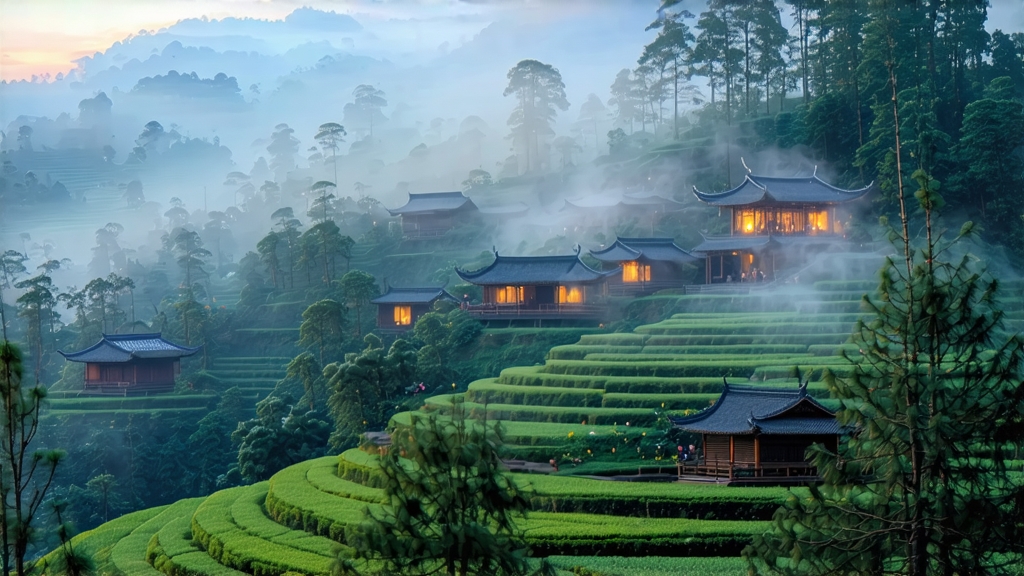
Long before English merchants coined the word “black tea,” Chinese mountain folk in the Wuyi massif of Fujian were already charcoal-drying leaves over smoldering pine boughs. The tea they created—Lapsang Souchong—became the first fully oxidized leaf in recorded history, the prototype that would travel across oceans and inspire Assam, Ceylon and Keemun. Today, while mass-market copies rely on artificial flavoring, the authentic village-level Zheng Shan Xiao Zhong remains a living fossil of craft, scent and story.
-
A leaf born of bandits and barter
Legend places the birth moment in 1568, late Ming dynasty, when army deserters forced tea farmers to abandon freshly picked leaves. By the time the soldiers left, the green leaf had oxidized to a coppery red. To mask the musty edge and accelerate drying, the farmers fired the leaves over green pine and cypress in a hurry. The result—sweet resin, dried longan and a whiff of smoked meat—delighted the next passing trader, who paid triple the usual price. Within decades, Dutch and later British East India ships were loading “Bohea Souchong” at Canton, introducing Europe to what they would call “black” tea. -
Terroir: one ridge, two rivers, three microclimates
Authentic Zheng Shan Xiao Zhong can only be produced inside the 60 km² core of the Wuyi National Nature Reserve, where the Jiuqu (Nine-Bend) Stream carves granite gorges shrouded in 80 % humidity year-round. Day-night temperature swings of 15 °C slow the growth of the indigenous Xingcun Xiaoye cultivar, concentrating amino acids and sugar. The same mist that nurtures cliff-grown oolong also deposits mineral-rich dew on lower-elevation tea bushes, giving Lapsang its signature sweet finish beneath the smoke. -
From pluck to perfume: the craft in four acts
a. Picking: only the second leaf with one bud, taken before the Qingming festival when spring bamboo shoots are thumb-length.
b. Withering: 8–10 h on bamboo racks inside semi-open sheds, where pine logs smolder 2 m below. The smoke is cool (28–32 °C) and fragrant with resin; leaves lose 60 % moisture while absorbing α-pinene and creosol.
c. Rolling: 45 min on cedar-wood trays, breaking cell walls to release polyphenol oxidase. Oxidation proceeds in pine-wood crates covered with wet cloth; masters sniff every 20 min, waiting for the leaf to turn chocolate-brown with a reddish rim.
d. Firing: the “hong long” (basket firing) finishes the tea over embers of 40-year-old Masson pine roots. Craftspeople toss leaves every five seconds; palms read temperature like a blacksmith’s. A final 90 °C bake fixes the smoke and lowers moisture to 4 %. -
Two faces of the same leaf
Traditional Song Zhong (Pine-Smoked): leaves are jet-black, tight and glossy; liquor glows deep amber; aroma layers pine tar, dried lychee and a hint of cacao. Modern Un-Smoked (Wu Zhong): developed for the domestic market in 2005, dried with electric heat and charcoal from lychee wood; cup profile is honeyed peach, rosehip and mineral rock sugar, proving that Wuyi terroir alone can sing without the campfire cloak. -
Brewing: gongfu versus teabag diplomacy
Gongfu style (recommended): 5 g in a 120 ml zisha or porcelain gaiwan, 90 °C water, flash rinse, then 5 steeps of 10 s, 15 s, 25 s, 40 s, 60 s. Watch the “golden ring” of foam on the first pour—an indicator of fresh pine oil. Western pot: 2.5 g per 250 ml, 95 °C, 3 min. Avoid boiling water directly on un-smoked versions; it flattens the peach note. Pair with dark chocolate, aged gouda or Cantonese char siu to echo the tea’s caramelized crust. -
Tasting sheet: what to hunt for
Dry